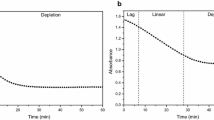Abstract
The reliability of kinetic substrate quantification by nonlinear fitting of the enzyme reaction curve to the integrated Michaelis–Menten equation was investigated by both simulation and preliminary experimentation. For simulation, product absorptivity ε was 3.00 mmol−1 L cm−1 and Km was 0.10 mmol L−1, and uniform absorbance error σ was randomly inserted into the error-free reaction curve of product absorbance Ai versus reaction time ti calculated according to the integrated Michaelis–Menten equation \( \ln \left[ {Am/\left( {Am - Ai} \right)} \right] + Ai/\left( {\varepsilon \times Km} \right) = \left( {Vm/Km} \right) \times ti \). The experimental reaction curve of arylesterase acting on phenyl acetate was monitored by phenol absorbance at 270 nm. Maximal product absorbance Am was predicted by nonlinear fitting of the reaction curve to Eq. (1) with Km as constant. There were unique Am for best fitting of both the simulated and experimental reaction curves. Neither the error in reaction origin nor the variation of enzyme activity changed the background-corrected value of Am. But the range of data under analysis, the background absorbance, and absorbance error σ had an effect. By simulation, Am from 0.150 to 3.600 was predicted with reliability and linear response to substrate concentration when there was 80% consumption of substrate at σ of 0.001. Restriction of absorbance to 0.700 enabled Am up to 1.800 to be predicted at σ of 0.001. Detection limit reached Am of 0.090 at σ of 0.001. By experimentation, the reproducibility was 4.6% at substrate concentration twice the Km, and Am linearly responded to phenyl acetate with consistent absorptivity for phenol, and upper limit about twice the maximum of experimental absorbance. These results supported the reliability of this new kinetic method for enzymatic analysis with enhanced upper limit and precision.





Similar content being viewed by others
Abbreviations
- Km :
-
Michaelis–Menten constant of the tool enzyme
- Vm :
-
Maximum reaction rate of enzyme
- Am :
-
The maximum of product absorbance
- ti :
-
Specified reaction time
- Ai :
-
Product absorbance at specified reaction time
- σ:
-
Random absorbance error
- Pi :
-
Product concentration at specified reaction time
- CV:
-
Coefficient of variation
- Qmin :
-
Least sum of the residual squares for the fitting
- R2 :
-
Determination coefficient
- Wi :
-
Weighting factor for each datum during the fitting
- ε:
-
Millimolar absorptivity of product
References
Guilbault GG (1976) Handbook of enzymatic methods of analysis. Marcel Dekker, New York
Gould BJ, Lukas BF (1985) Enzymes for clinical analysis. In: Wiseman A (ed) Handbook of enzyme biotechnology, 2nd edn. Ellis Horwood, Chichester
Sampson EJ, Baird MA (1979) Clin Chem 25:1721–1729
Mieling GE, Pardue HL (1978) Anal Chem 50:1611–1618
Mieling GE, Pardue HL, Thompson JE, et al (1979) Clin Chem 25:1581–1590
Harris RC, Hultman E (1983) Clin Chem 29:2079–2081
Hamilton SD, Pardue HL (1982) Clin Chem 28:2359–2365
Liao F, Liu W-L, Zhou Q-X, Zeng Z-C, Zuo Y-P (2001) Clin Chim Acta 314:67–76
Laidler KJ, Bunting PS (1973) The chemical kinetics of enzyme reaction, 2nd edn. Clarendon Press, Oxford
Orsi BA, Tipton KF (1979) Methods Enzymol 63:159–183
Gan KN, Smolen A, Eckerson HW, La Du BN (1991) Drug Metab Dispos 19:100–106
Miller JC, Miller JN (1988) Statistics for analytical chemistry, 2nd edn. Ellis Horwood, Chichester
Baywenton PR (1986) Data processing and error analysis. Knowledge Press, Beijing
Atkins GL, Nimmo IA (1973) Biochem J 135:779–784
Draper NR, Smith H (1981) Applied regression analysis, 2nd edn. Wiley, New York
del Rio FJ, Riu J, Rius FX (2001) Analyst 126:1113–1117
Liao F, Wang J-H, Zeng Z-C, Kang G-F, Zuo Y-P, et al (2003) Disan Junyi Daxue Xuebao 25, in press
Acknowledgement
This work was supported by National Natural Science Foundation of China (No. 30200266).
Author information
Authors and Affiliations
Corresponding author
Rights and permissions
About this article
Cite this article
Liao, F., Tian, KC., Yang, X. et al. Kinetic substrate quantification by fitting the enzyme reaction curve to the integrated Michaelis–Menten equation. Anal Bioanal Chem 375, 756–762 (2003). https://doi.org/10.1007/s00216-003-1829-x
Received:
Revised:
Accepted:
Published:
Issue Date:
DOI: https://doi.org/10.1007/s00216-003-1829-x




